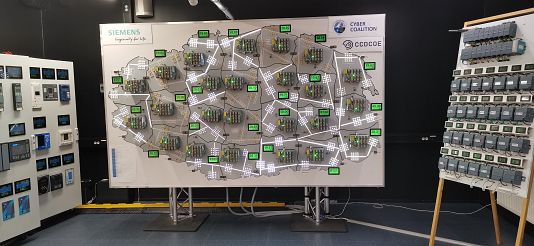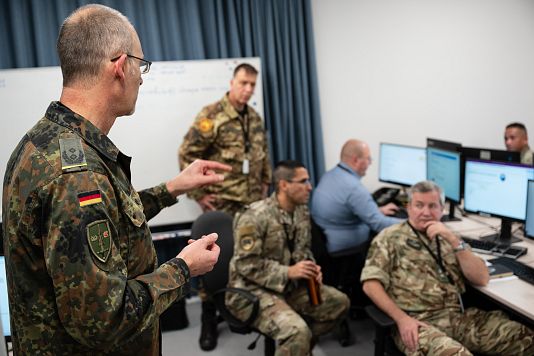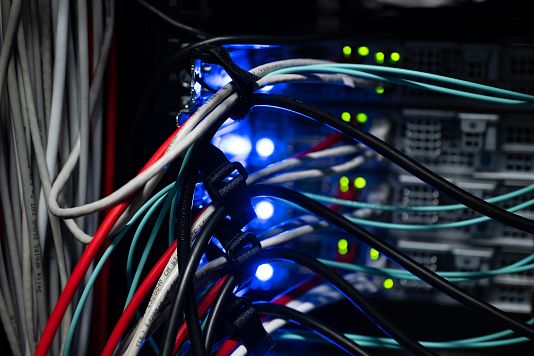Pascale Davies
At the touch of a button, a soldier holding a laptop sends sparks flying on a circuit board, causing a power generator to flash bright red as a beeping sound grows louder. This is the representation of a country’s power infrastructure coming under a cyber attack.
Though the map of circuit boards depicts a fictional island, with streets called “Blockchain Street” and “Macintosh Street,” a real-life cyber attack may not be as visible as this. Still, the effects on infrastructure can be just as devastating, causing homes to lose power or water.
The scenario is just a simulation but it serves as a training ground for soldiers who are at the NATO Cyber Range in Estonia’s capital Tallinn.
At the CR14 NATO Cyber Range, around 145 on-site commanders from as many as 30 countries - most of them NATO countries but some not - are put to the test on how they would prevent a cyber attack.
Inside the three-storey building which houses it, the first floor is where food and refreshments are provided and some of the innovations are showcased. The second floor is used for training and where phones are not allowed. And the third floor is where the real action happens, but is out of bounds for journalists.
Ukraine and Article 5
NATO’s week-long cyber operation, which took place last week, is an annual affair. This year has seen the most participants, which comes as no surprise given the war in Ukraine.
“What we've seen in Ukraine is really nonstop cyberattacks since February, since really just even before the war started,” said David Cattler, assistant secretary general for intelligence and security at NATO.

Image shows the map of circuit boards and power generator used for simulation exercises.Euronews
“Additional cyber operations are ongoing… Some of these operations have been linked to the Russian military intelligence, to the GRU, and are clearly designed to cause psychological effects and to exhaust cyber defence resources, which again highlights the role that cyber plays in a crisis and is played in this war,” he said.
NATO takes cyberattacks so seriously that its secretary-general, Jens Stoltenberg said this year that cyberattacks against a NATO member could trigger Article 5, meaning it is considered an attack on all NATO members and the alliance could react.
Truth in fiction
Back at the Cyber Range, made-up storylines for the participants to solve involve the fictitious island of “Icebergen,” home to the nations of supposed NATO member “Anduaria” and “Harbardus,” an enemy.
“It [the situation in Ukraine] brings more of a seriousness in terms of how this actually happens. It's not as fictitious anymore. And that's the difference that this thing brings,” Bernd Hansen, Branch Head of Cyberspace at the NATO Allied Command Transformation, told Euronews Next.
Although the storylines are kept very secret by the participants and NATO, they do say it can include infrastructure attacks, network intrusion, and potential insider threats.
I have felt really, really proud to be treated really warm-heartedly. And part of this is because there are people who I walk around with here and they sort of treat me as an ally.
Markus Riihonen
Major Defence Commander in the Finish Defence Forces
But the focus is on how each participating country shares information and can help the other out in the event of an attack, rather than competing with each other.
This is called the “locked shields” operation, a real-life exercise in which they would react and help other countries.
“I believe, it sets the focus on collaboration and nothing else, because if you start competing, you tend to be in a situation where you don't share as much because you want to be in a good situation in locked shields and you could get points by sharing,” said Tobias Malm, a Swedish Armed Forces major in cyber defence.
“Of course, there will always be a competitive side in that sense that all technicians want to solve the technical issues by themselves and be the first ones to solve them. So in that sense, that's a competitive ingredient in the exercise,” he told Euronews Next.
Although it’s not currently a NATO member, Sweden may soon be after NATO members quickly welcomed its application to join the alliance alongside neighbour Finland following Russia’s invasion of Ukraine.
But it is not the first time that Sweden has participated in NATO’s training programmes.
“We have been in this exercise for I think 10 or 12 years. So it's nothing new,” Malm said.

Image shows cyber security experiments being palyed out at the cyber range.NATO
“But for us working together regarding cyber defence is good, we learn a lot and I think we can bring something new to NATO with regards to how we work and also regarding how we work”.
Although both Sweden and Finland have been here before, this year has been important for the countries.
“This year we have made improvements in capability and in information exchange,” said Markus Riihonen, Major Defence Commander in the Finish Defence Forces.
“I have felt really, really proud to be treated really warm-heartedly. And part of this is because there are people who I walk around with here and they sort of treat me as an ally,” he told Euronews Next.
“I'm looking forwards to having two very high-level cyber security countries [Finland and Sweden], which is very beneficial for them [NATO]. This is what they [NATO] have let me know that they are very much looking forward to the accession and integration in the future”.
Tech innovations
With the numerous cyber security start-ups in Finland and Sweden, NATO has all the reason to be excited about the countries joining.
“We're very much looking forward to being able to welcome Finland and Sweden into our innovation ecosystem to maintain our technological edge. I mean, they're their world-class partners or invitees now, and there'll be work real close allies as well” said David van Weel, NATO’s Assistant Secretary-General for Emerging Security Challenges.
The threat from cyberspace is real and it's growing and we need to do more investment more in our enhancing our cyber defences, more expertise, more enhance cooperation, also with the private sector
David van Weel
NATO Assistant Secretary-General for Emerging Security Challenges
“These are two very capable countries, especially when it comes down to the field of innovation. They have a history of strong engagement with their private sectors. They have flourishing innovation ecosystems,” he said.
Van Weel said working with the private sector and academia will prove crucial to cyber defence, which can be seen in how companies like Starlink and Microsoft have helped Ukraine.
“NATO is committed to maintaining its technological edge and exercises like the cyber coalition, help us to test and put these new technologies into practice,” he said.
“The threat from cyberspace is real and it's growing and we need to do more investment more in our enhancing our cyber defences, more expertise, more enhance cooperation, also with the private sector”.
In the NATO Cyber Range building, innovation is on show in the shape of the world’s first 5G scooters that whizz around the long corridors. Although it is only there for inspiration, it shows how transportation operating on 5G could come under attack.
Similarly, there is also a battleship simulator, which could come under cyber attack if the digital map the vessel uses were hacked and countries or islands disappeared.
But the biggest test for the participating countries is on infrastructure, such as street lights, water supply and heating coming under cyber attack.
This, in the real world, is a serious threat, which Ukraine has experienced since October after Russia began attacking its energy infrastructure, leaving around 30 per cent of power stations across the country destroyed and many without heating or light in the winter.

Image taken from CR14 Cyber Range in Tallinn, EstoniaNATO
Georgia, which also neighbours Russia, is also worried about cyber attacks. The post-soviet country, which is not a NATO member, was attacked by Russia 13 years ago in a five-day war.
Much of Georgia’s infrastructure is also Soviet in design and installation.
“For the Ministry of Defence cyber security is one of the top priorities because we are facing a lot of a lot of challenges,” said Nika Gogindze from Georgia’s ministry of defence on cybersecurity.
He said NATO’s cyber security week has allowed him to improve Georgia’s cyber cooperation with other countries.
“Our aim was to improve the coordination with our allies and its nature and decrease the time in finding new ways for communicating with them during the cyber attack crisis.
“So the goal was achieved and I am so happy with that”.
As the week ends, so does of course any cyber trace of the operations that happened. All email logins are wiped from the building and a new week begins for new cyber training operations.
No comments:
Post a Comment